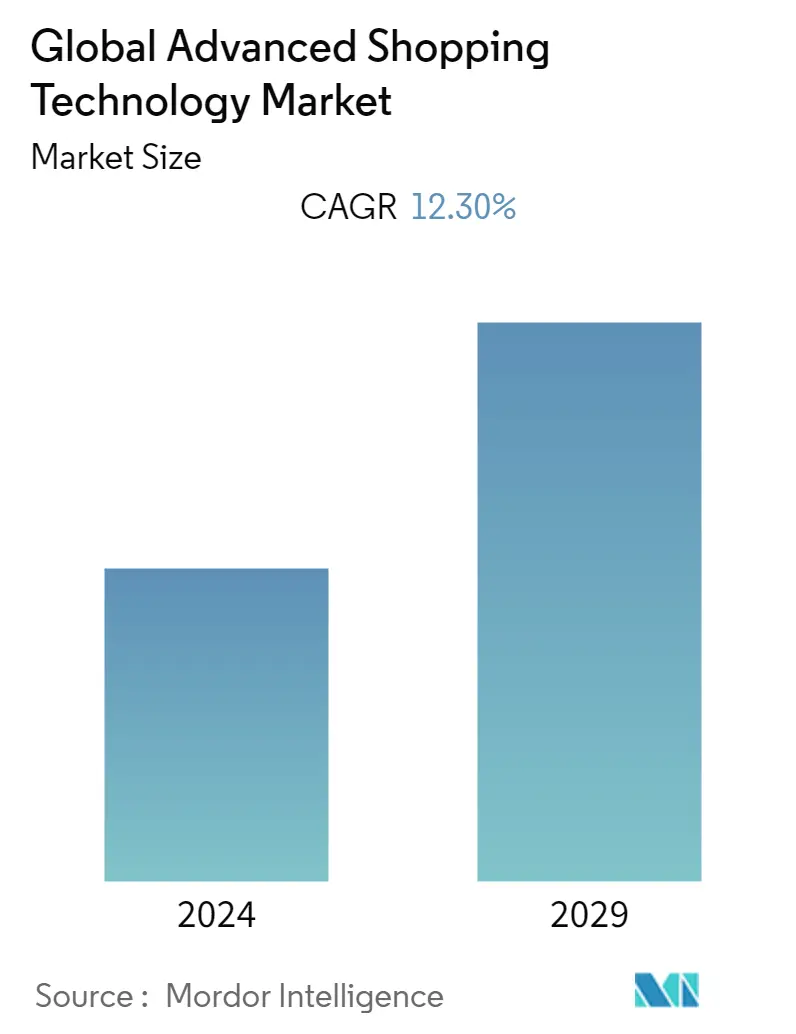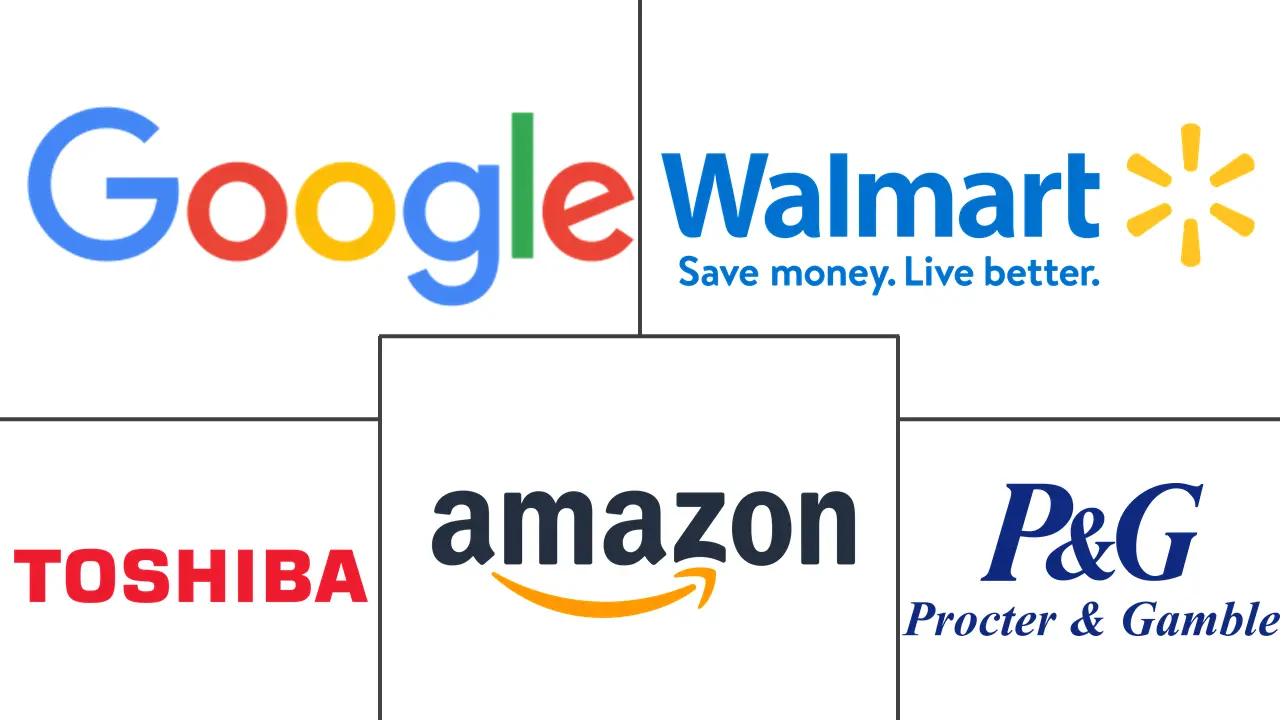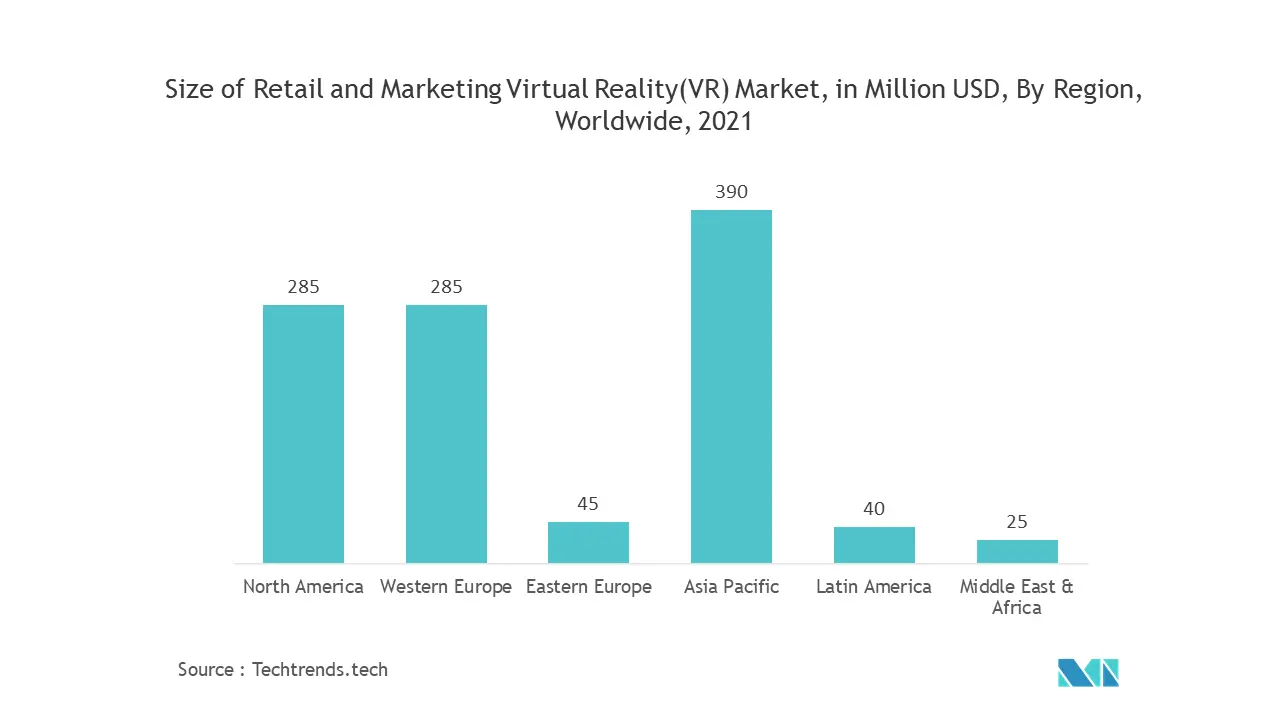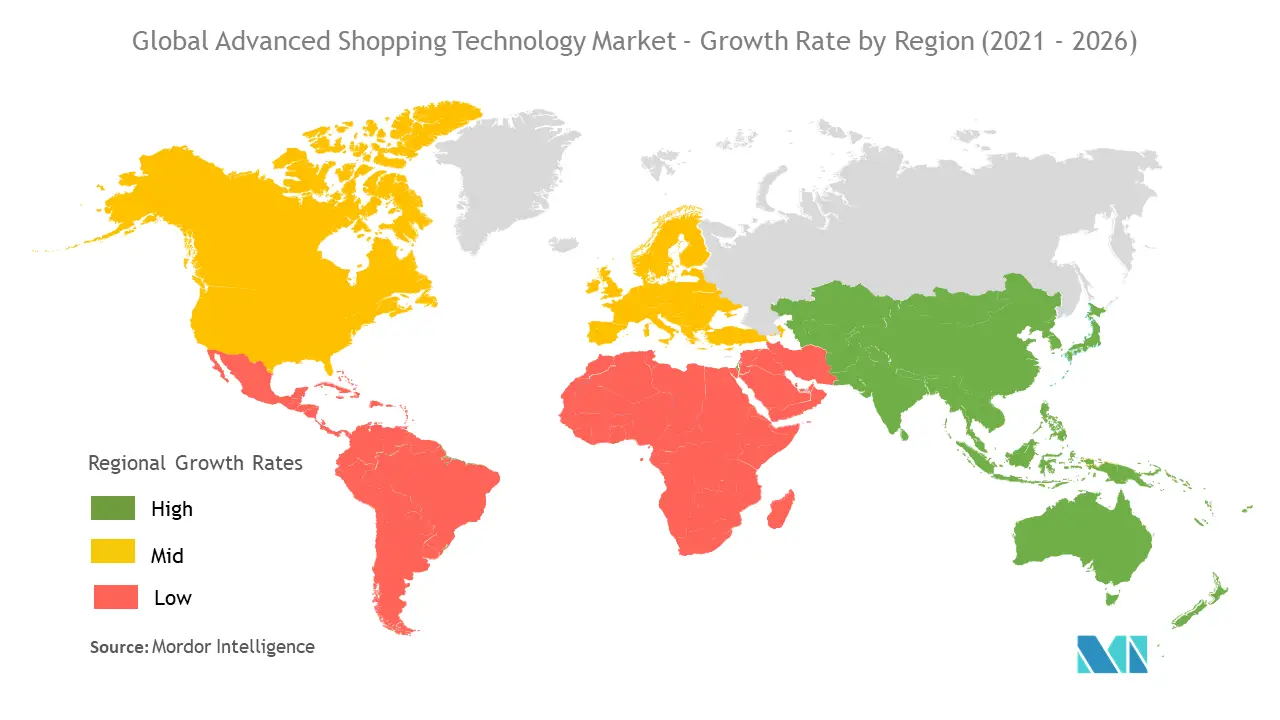Advanced Shopping Technology Market Size

| Study Period | 2019 - 2029 |
| Base Year For Estimation | 2023 |
| CAGR | 12.30 % |
| Fastest Growing Market | Asia-Pacific |
| Largest Market | North America |
| Market Concentration | High |
Major Players
*Disclaimer: Major Players sorted in no particular order |
Advanced Shopping Technology Market Analysis
The advanced shopping technology market is expected to witness a CAGR of 12.3 % over the forecast period (2021-2026). Customers' shopping experiences can be streamlined by using advanced shopping technologies to provide personalization and convenience options while they shop. With technical advancements, internet shopping and purchasing via smart devices are becoming more popular. Consumer behavior is influenced by technological advancements and a rise in convenience expectations.
- According to sponsor pulse, In 2020, more than 80% of consumers worldwide purchased online, with South America and Asia leading the way with nearly 90% each. North America had the lowest percentage, with slightly over three out of four customers shopping online. A huge number of consumers are preferring online shopping to traditional shopping, which will drive the companies to incorporate the latest technology in their electronic shopping tools.
- Further, according to Consumer Technology Association, smart city initiatives are expected to reach USD 34.35 billion in 2020. This further augments the demand for smart kiosks in the region as the United States leads smart city spending globally. Some cities, such as Nevada, have done the deployment of interactive kiosks at several retail locations across the state. Several other states in the United States have also begun to experiment with these interactive kiosk machines. Georgia has introduced a bill payment interactive kiosk to allow the residents to renew their car tags. Ohio has also deployed several interactive kiosks to facilitate automated vehicle registration.
- In 2020, Walmart, the largest retail chain in North America, has over 11,000 brick and mortar outlets, with approximately as many online stores. It was possible to manage this large infrastructure with the help of AI and machine learning (ML) integrated with the IoT. Voice-based search by Google Assistant, facial recognition software, and cross-technology solutions have made the retail industry scale up to higher revenues for several years.
- In October 2021, GoDaddy designed the new POS system to ensure it was fully integrated with WooCommerce to allow online stores to incorporate in-person selling with their existing sites faster so they could start selling right away. This integration minimizes the costs and inventory control with the functionality of a store to simplify the inventory process and help track, manage a stand-alone warehouse or a chain of stores.
- The companies are developing products with the prediction of incorporation of artificial intelligence in their solution/Services. For example, Microsoft has Azure IoT for retail delivers operational excellence, an intelligent supply chain, and more powerful business intelligence enables organizations to deliver significant customer experiences that drive affinity and create loyalty.
- Since the outbreak of the COVID-19 virus, governments have instituted lockdowns to prevent the infection from spreading, forcing people to stay at home. Digital transactions, online shopping apps, and e-commerce apps have all experienced an increase in the lockdown and coronavirus epidemic. Increased use of such apps is expected to propel market growth.
Advanced Shopping Technology Market Trends
This section covers the major market trends shaping the Advanced Shopping Technology Market according to our research experts:
Increasing Adoption of Virtual Reality in the Retail Sector is Expected to Drive the Market
- Retail is one of the major sectors where customer engagement is imperative for businesses. According to the 2021 Retail Digital Transformation Survey by BDO USA, 35% of the respondents suggested that the top digital priorities include improving customer experience. Virtual Reality assists in improving customer engagement, increasing brand awareness and driving sales conversions.
- According to IBM's 2020 US Retail Index report, the pandemic has expedited the shift to digital purchasing by about five years. Virtual try-before-you-buy experiences range from previewing furniture and house products of brands such as IKEA and Home Depot to digitally trying on luxury fashion brands such as Louis Vuitton and Gucci.
- Also, according to a 2020 survey by GetApp, 60% of the respondents from the United Kingdom stated that using VR would minimize the risk of infection as there is less interaction with people or trying clothes that someone else has already tried on. About 54% of respondents state that the perception of VR and willingness to use it has changed because of COVID-19. The growth of virtual stores also presents new opportunities for the market.
- Out of these, almost half (45%) stated that they are more willing to use it than before the pandemic. In Spain, 62% of the respondents stated that Covid-19 has led to an increase in the adoption of VR for shopping, followed by France (42%) and Germany (36%). Respondents considered that 360-degree videos assist in understanding the product better (60%) and add entertainment to the shopping experience (51%). 44% said that it could improve the perception of a brand, while 45% stated that this content helps to make a better purchase decision. (n=5,080; Europe).
- Further, in 2020, Tommy Hilfiger and Charlotte Tilbury partnered with e-commerce software provider Obsess to create their own virtual stores. The virtual stores blend details with familiar elements, such as doors and cameras at human height, to make them more palatable. The increasing integration of VR in retail is propelling the growth of the studied market.

North America is Expected to Hold a Major Market Share
- Robots coupled with artificial intelligence are expected to help stores cut costs and advance store processes by cleaning, transforming goods from shelves, following, unraveling shelf inventory, and offering last-mile delivery.
- Amazon.com is poised to bring its automated checkout technology to full-size supermarkets. The company is planning for a store under construction in Brookfield, Connecticut. The store contains all the essentials of an Amazon Fresh grocery store: a two-word logo on dark gray panels above the store’s entrance, an online order pickup counter, and such full-service departments as a butcher. The plans also identify a dozen entry and exit gates, along with ceiling-mounted racks to run wiring to camera arrays. This setup until now has only appeared in Amazon Go convenience stores.
- Shoppers enter the location by swiping a smartphone at the entry gate. Inside the store, the shoppers would be tracked by cameras, software algorithms, and shelf sensors-then charged for what they take when exiting through the designated gates.
- Further, Aldi plans to adopt the checkout-free retail technology. In August 2020, According to ChargedRetail, Aldi had “placed an international call out to tech startups specializing in computer vision and artificial intelligence,”
- Also, in June 2021, Instacart Inc. plans to replace its army of gig shoppers with robots as a part of its long-term strategy to cut costs and put its relationship with supermarket chains on a sustainable footing. The plan involves building automated fulfillment centers around the U.S., where hundreds of robots would fetch cereal boxes and soup cans while humans gather produce and deli products.

Advanced Shopping Technology Industry Overview
The Global Advanced Shopping Technology Market is a concentrated market with a few prominent players like Google LLC, Amazon.com, Inc., Toshiba Corporation, etc. Rapid technological advancements and the evolving customer requirements are driving the market players towards extensive research and development, collaborations, and innovations through partnership.
- September 2021: Google, owned by Alphabet Inc., has announced new search tools that will put images rather than words at the center of queries, possibly expanding its role in e-commerce and extending its domination in online video. Customers may now ask Google to find them the same pattern on another article of apparel, such as socks, by tapping on the Lens symbol while looking at an image of a shirt.
- June 2021: Amazon Fresh now offers 'Just Walk Out technology. The Just Walk Out system detects merchandise that shoppers remove from or return to shelves and tracks items selected in a virtual cart using overhead computer vision cameras, weight sensors, and deep-learning technologies. Customers are given the option of either Just Walk Out shopping or using the standard checkout lanes at the store's automatic entry gates. Those who choose Just Walk Out scan a QR code in the Amazon mobile app, scan their palm on the Amazon One palm signature device, or input a credit/debit card linked to their Amazon account to enter the store.
Advanced Shopping Technology Market Leaders
-
Google LLC
-
Walmart Inc.
-
Amazon.com, Inc.
-
Toshiba Corporation
-
Procter & Gamble Company
*Disclaimer: Major Players sorted in no particular order

Advanced Shopping Technology Market News
- June 2021: Toshiba's Self Checkout System 7 solution, developed by Toshiba Global Commerce Solutions and Calimax, provides fast, convenient, and frictionless checkout experiences. Calimax and Toshiba are designing the checkout experiences that shoppers want, thanks to user input and a collaborative approach, resulting in more checkout alternatives for customers and more sales.
- July 2021: Toshiba Global Commerce Solutions, the well-known player in retail store technology, has announced a strengthened partnership with Stor.ai, the end-to-end digital commerce solution for grocers. The relationship will allow store. ai'splatform to be fully integrated into the retailer's environment, giving their clients the capabilities to build a scalable, online storefront with full infrastructure.
Advanced Shopping Technology Market Report - Table of Contents
1. INTRODUCTION
- 1.1 Study Assumptions and Market Definition
- 1.2 Scope of the Study
2. RESEARCH METHODOLOGY
3. EXECUTIVE SUMMARY
4. MARKET INSIGHTS
- 4.1 Market Overview
-
4.2 Industry Attractiveness - Porter's Five Forces Analysis
- 4.2.1 Bargaining Power of Suppliers
- 4.2.2 Bargaining Power of Consumers
- 4.2.3 Threat of New Entrants
- 4.2.4 Threat of Substitute Products
- 4.2.5 Intensity of Competitive Rivalry
- 4.3 Technology Snapshot
- 4.4 Industry Value Chain Analysis
- 4.5 Assessment of Impact of COVID-19 on the Industry
5. MARKET DYNAMICS
-
5.1 Market Drivers
- 5.1.1 Increasing adoption of advance technology in retail sector
- 5.1.2 Artificial intelligence and robots in retail stores
-
5.2 Market Restraints
- 5.2.1 High cost of implementation of the technology
6. MARKET SEGMENTATION
-
6.1 By Product Type
- 6.1.1 Beacons
- 6.1.2 Virtual Reality
- 6.1.3 Smart Shelves
- 6.1.4 Retail Apps
- 6.1.5 Social Media and Showrooming
- 6.1.6 Others
-
6.2 By Application
- 6.2.1 Retail
- 6.2.2 Commercial Advertising
- 6.2.3 Others
-
6.3 By Geography
- 6.3.1 North America
- 6.3.2 Europe
- 6.3.3 Asia Pacific
- 6.3.4 Latin America
- 6.3.5 Middle East and Africa
7. COMPETITIVE LANDSCAPE
-
7.1 Company Profiles
- 7.1.1 Google LLC
- 7.1.2 Walmart Inc.
- 7.1.3 Amazon.com, Inc.
- 7.1.4 Toshiba Corporation
- 7.1.5 Procter & Gamble Company
- *List Not Exhaustive
8. INVESTMENT ANALYSIS
9. FUTURE OUTLOOK
** Subject To AvailablityAdvanced Shopping Technology Industry Segmentation
Global Advanced Shopping Technology Market is Segmented by Product Type (Beacons, Virtual Reality, Smart Shelves, Retail Apps, Social Media and Showrooming), Application (Retail, Commercial Advertising), and Geography.
By providing customers with convenient services and personalization while shopping, advanced shopping technology facilitates an efficient customer shopping experience.
| By Product Type | Beacons |
| Virtual Reality | |
| Smart Shelves | |
| Retail Apps | |
| Social Media and Showrooming | |
| Others | |
| By Application | Retail |
| Commercial Advertising | |
| Others | |
| By Geography | North America |
| Europe | |
| Asia Pacific | |
| Latin America | |
| Middle East and Africa |
Advanced Shopping Technology Market Research FAQs
What is the current Global Advanced Shopping Technology Market size?
The Global Advanced Shopping Technology Market is projected to register a CAGR of 12.30% during the forecast period (2024-2029)
Who are the key players in Global Advanced Shopping Technology Market?
Google LLC, Walmart Inc., Amazon.com, Inc., Toshiba Corporation and Procter & Gamble Company are the major companies operating in the Global Advanced Shopping Technology Market.
Which is the fastest growing region in Global Advanced Shopping Technology Market?
Asia-Pacific is estimated to grow at the highest CAGR over the forecast period (2024-2029).
Which region has the biggest share in Global Advanced Shopping Technology Market?
In 2024, the North America accounts for the largest market share in Global Advanced Shopping Technology Market.
What years does this Global Advanced Shopping Technology Market cover?
The report covers the Global Advanced Shopping Technology Market historical market size for years: 2019, 2020, 2021, 2022 and 2023. The report also forecasts the Global Advanced Shopping Technology Market size for years: 2024, 2025, 2026, 2027, 2028 and 2029.
Global Advanced Shopping Technology Industry Report
Statistics for the 2024 Global Advanced Shopping Technology market share, size and revenue growth rate, created by Mordor Intelligence™ Industry Reports. Global Advanced Shopping Technology analysis includes a market forecast outlook to 2029 and historical overview. Get a sample of this industry analysis as a free report PDF download.



